The Old White Lion – A History
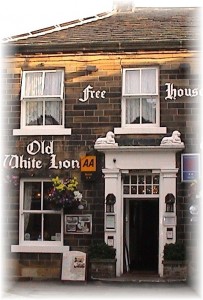 Family run for the past 25 years the present custodians of the Building hope you like what you see. Family run for the past 25 years the present custodians of the Building hope you like what you see.
The continuing alterations whilst always trying to modernize are always done whilst trying to retain the Heritage & History of the Building – if only walls could talk wouldn’t there be a tale to tell.
The Old White Lion Hotel has altered immensely in the 19th Century expanding to the North West by incorporating the
Old Cycling Club which originally met at No 12 West Lane (or Towngate) & No 14 West Lane which was the Old proprietors accommodation.
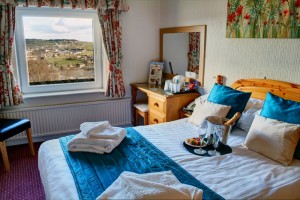
To the North East Façade the property on the Ginnel now called Changegate properties Numbers 1 & 3 were incorporated to form what is now the Front Bar (more commonly known as the Cocktail Bar) Numbers 5 & 7 were added to form the Function Room now the Back Lounge Bar. The Car Park was developed from the demolition of Numbers 9 & 11 plus the infill of the old Ash pits.
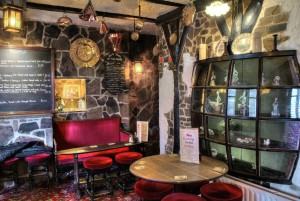 Most recently in the 1970’s the Old Coaching Yards, Brewhouse & Barn in the centre which is supposed to contain the Old Well was developed to form the inclusion of Rooms 8-12 & the Changegate Bar. More recently the Changegate Bar was developed to create the Bramwell Suite you see today. The old Function room was developed into what is now the Back Bar area & with the addition of en-suites into all the Bedrooms & incorporation of the Owners Accommodation. Nearly all the roofs, rooms & walls have been redeveloped with all the Owners Flats Downstairs. Most recently in the 1970’s the Old Coaching Yards, Brewhouse & Barn in the centre which is supposed to contain the Old Well was developed to form the inclusion of Rooms 8-12 & the Changegate Bar. More recently the Changegate Bar was developed to create the Bramwell Suite you see today. The old Function room was developed into what is now the Back Bar area & with the addition of en-suites into all the Bedrooms & incorporation of the Owners Accommodation. Nearly all the roofs, rooms & walls have been redeveloped with all the Owners Flats Downstairs.
 The early years The early years
The date at which there was first a public house at the corner of Haworth’s village green at the top of Main Street is not known. The first recorded name is the Blue Bell Inn some time before 1783 and it may well be that the inn dates to the early days of the 1755 Blue Bell turnpike road from Bradford to Colne which passes the front door. Certainly by 1783 the place had acquired the name of the White Lion Inn and it was run by Jeremiah Jowett who rented it for £17 a year.
One of our earlier notices of the White Lion dates from the end of the eighteenth century and records that Haworth’s first Masonic lodge met here. This was the Prince George Lodge which met at the White Lion from 1796 to 1802 and again from 1809 to 1812. The Prince George Lodge amalgamated in the latter year with the Three Graces Lodge which met at the Black Bull and the Prince George name was transferred to a lodge in the Todmorden area.
William Garnett bought the White Lion in the 1820s and ran it for about twenty years. He died in 1859 after a long retirement and is buried in St. Michael’s churchyard nearby.
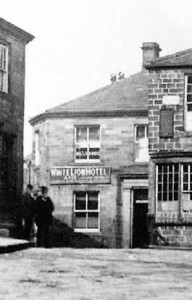 In 1850 the Lion was bought by J. & R.R. Thomas, prominent citizens of Haworth in the Bronte era who were wine and spirit merchants. They also owned the Cross Inn opposite the Church gates (formally Snowden’s grocery shop now The Steam Brewery). During the Thomas’s ownership the place was rebuilt – being described as recently rebuilt in a document of 1858. This was probably not before time as B.H. Babbage writing a few years earlier had this to say: In 1850 the Lion was bought by J. & R.R. Thomas, prominent citizens of Haworth in the Bronte era who were wine and spirit merchants. They also owned the Cross Inn opposite the Church gates (formally Snowden’s grocery shop now The Steam Brewery). During the Thomas’s ownership the place was rebuilt – being described as recently rebuilt in a document of 1858. This was probably not before time as B.H. Babbage writing a few years earlier had this to say:
‘In a back yard in the Ginnel belonging to the White Lion, I found a large midden-stead with offal and garbage from a slaughter-house in it; the drainage from this place flowed over the pavement of the yard in its way to the street drain. Some of the neighbours complained of this nuisance.’
It would seem that the pub sign played an unusual role around this time in the neighbouring village of Stanbury. A friend of the Thomas family recorded that a wooden lion ‘apparently some publican’s sign’ was placed in the pulpit at the Wesleyan Chapel in Stanbury to play a leading role in the sacred drama Daniel in the Lion’s Den.
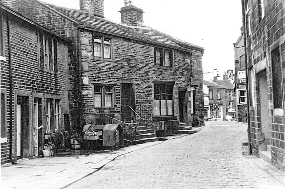 There was a succession of tenants during these years but in the 1860s it passed into the hands of John Pickles – bynamed Johnny Broth – who ran the establishment himself until 1875 when he was succeeded by his wife Susey who ran it until 1881. During her time the White Lion also served as a Posting House. Her son William was described as a coachman. There was a succession of tenants during these years but in the 1860s it passed into the hands of John Pickles – bynamed Johnny Broth – who ran the establishment himself until 1875 when he was succeeded by his wife Susey who ran it until 1881. During her time the White Lion also served as a Posting House. Her son William was described as a coachman.
After this the Lion was acquired by Samuel Ogden who owned one of Haworth’s two principal breweries. His premises were situated at the Fallwood Brewery at the bottom of the village not far from the railway station.
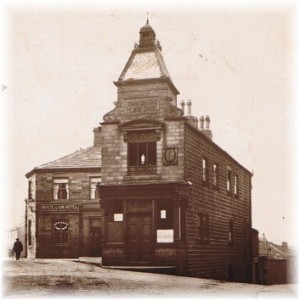
When Ogden’s ceased brewing around the beginning of the First World War they leased the inn first to Whitaker & Co. of Halifax and later to Bentley’s Yorkshire Brewery
|